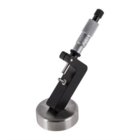If the Lee is leaving impressions in the neck wall, it means you're applying too much pressure. Back off the die a bit. I use the Lee neck sizer and raise the ram only part way while feeling the case being sized SOME, then lower the ram, rotate the case 90 degrees and go all the way up on the ram. Run out is below .001
Nothing wrong in my way of thinking with two firings before bumping the shoulder back. It just means cases are fully fire formed. Of course, if you're shooting competitively you don't want your string interrupted by a hard to chamber round, so FL or shoulder bump every time is a good plan.
I have also had many an off center round shoot right into the group, but then I'm not shooting in competition.
Interestingly there are some posts recently referring to studies utilizing ultra short barrels and high speed photography where it is clear that the force of the primer detonation unseats the bullet before the powder charge ignition, and ramming the bullet into lands.
Now imagine a perfectly sized brass with zero neck/bullet run out but with a couple of thou. clearance between the case wall the the chamber. The round is going to set slightly cocked in the chamber and when the bullet unseats and is driven forward it may engrave just slightly off axis with the barrel.
I've read that some competition shooters will mark the high point of neck runout, and chamber the round with the mark at a specific orientation, perhaps helping to engrave the bullet more inline with the axis of the barrel.
In the final analysis, I am a firm believer that anything one does to increase confidence in ones self has more to do with success than most of these little tweaks actually do.
Nothing wrong in my way of thinking with two firings before bumping the shoulder back. It just means cases are fully fire formed. Of course, if you're shooting competitively you don't want your string interrupted by a hard to chamber round, so FL or shoulder bump every time is a good plan.
I have also had many an off center round shoot right into the group, but then I'm not shooting in competition.
Interestingly there are some posts recently referring to studies utilizing ultra short barrels and high speed photography where it is clear that the force of the primer detonation unseats the bullet before the powder charge ignition, and ramming the bullet into lands.
Now imagine a perfectly sized brass with zero neck/bullet run out but with a couple of thou. clearance between the case wall the the chamber. The round is going to set slightly cocked in the chamber and when the bullet unseats and is driven forward it may engrave just slightly off axis with the barrel.
I've read that some competition shooters will mark the high point of neck runout, and chamber the round with the mark at a specific orientation, perhaps helping to engrave the bullet more inline with the axis of the barrel.
In the final analysis, I am a firm believer that anything one does to increase confidence in ones self has more to do with success than most of these little tweaks actually do.
















